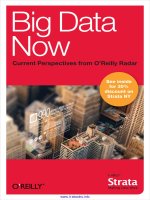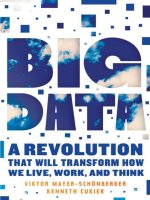Whos big on big data
Bạn đang xem bản rút gọn của tài liệu. Xem và tải ngay bản đầy đủ của tài liệu tại đây (463.05 KB, 11 trang )
A report from the Economist Intelligence Unit
Views from the C-suite
Who’s big on
BIG DATA?
Sponsored by
Views from the C-suite: Who’s big on big data?
Executive
summary
The way that big data pervades most organisations
today creates a dynamic environment for C-level
executives to explore how it can and should be
used strategically to add business value. While
each C-level executive views big data through a
unique lens, a strong consensus exists among
them about the need for effective big data
analytics across their organisations.
The EIU survey shows that senior executives are
optimistic about both the capabilities of big data
and the impacts such data can have on their
businesses. They display a clear understanding of
big data’s potential, with the majority admitting
that they would like to achieve deeper knowledge
of the underlying data-related technologies. This
need for better understanding will only grow as the
application of big data across a wide array of
corporate activities increases beyond customerfacing functions.
While executives at the helm of organisations
recognise the growing importance of big data, they
still struggle with its proper application. An
important question remains: Whose responsibility
is it to manage this growing suite of big-data
applications? According to our survey: everyone’s.
Disagreement arises, however, about who exactly
should lead the charge. CEOs understand the
strategic importance of big data, but they admit
their knowledge of its applications is limited. And a
majority of executives across all functions believe
that big-data applications are too large to be left
to those who have the most understanding of
these applications: CIOs. The CMOs are also
well-versed in big data but not its application
across other functions. Like the CMOs, CFOs are
eager consumers of big data, but they are not savvy
about big data’s use outside finance.
As a result, big data today tends to be siloed
within organisational departments. The survey
indicates, however, that executives realise that it
should be a shared responsibility, one that is
coordinated across the enterprise. A large
proportion of respondents say that big data can
enhance the strategic role of their function, and
About the survey?
In September 2014, The Economist Intelligence
Unit (EIU) carried out a global survey of 395
C-level executives with sponsorship from Platfora.
The survey sample consists of executives from 18
different industries and is balanced across Asia-
1
© The Economist Intelligence Unit Limited 2014
Pacific (34%), North America (27%), Western
Europe (26%) and the rest of the world (13%).
About half of respondents’ organisations have
annual revenue of more than $500m, of which onein-five report more than $5bn in revenue.
Views from the C-suite: Who’s big on big data?
they see the creation of enterprise-wide big-data
teams as the most effective strategy for realising
maximum value.
Here we explore in more detail the different
C-suite beliefs, priorities and opinions on the
subject of big-data analytics gleaned from the EIU
survey:
Finding 1: Executives’ attitudes towards big
data are overwhelmingly positive
A great majority of executives agree that big data has
a substantial role to play in their organisation’s
future. Nearly half (48%) believe big data to be a
useful tool, while another 23% say big data will
revolutionise the way businesses are managed. More
than one-in-five (21%) consider big data essential to
managing increasing information flow. (See Chart 1)
CEOs have the most positive overall attitudes
about big data according to survey respondents,
with 76% rating their CEO’s views as positive or
very positive on the subject, closely followed by
CIOs (72%) and CMOs (67%). (See Chart 2)
This generally positive outlook is not limited to
any single business challenge. When asked how
effectively big-data analytics could help to guide
strategic decisions, increasing sales receives the
highest ratings with 84%. But a great many also
point to other key strategic challenges—including
improving efficiency (78%) and building customer
loyalty (73%). Even the lowest-rated challenge,
minimising costs, is seen as a good candidate for
big-data analytics by two-thirds (67%) of
executives.
Chart 1. Which of the following statements most closely describe your view of the future of big data?
% of respondents
Big data will be a useful tool among many
other emerging technologies
48
Big data will revolutionise the way
businesses are managed
23
Big data is essential to deal with rapidly
increasing volumes of information
Big data is a fad that will pass
in due time
21
3
Source: Economist Intelligence Unit survey, September, 2014.
Chart 2. What is the overall attitude towards big data among your C-level colleagues?
% of respondents who selected “positive” or “very positive”
76
Chief executive officer
72
Chief information officer
61
Chief operating officer
64
Chief financial officer
67
Chief marketing officer
Chief risk officer
54
59
Chief data officer
Chief information security officer
53
Source: Economist Intelligence Unit survey, September, 2014.
2
© The Economist Intelligence Unit Limited 2014
Views from the C-suite: Who’s big on big data?
Finding 2: Executives agree on the need for
big-data solutions and want to know more
C-level executives clearly articulate the potential
of big-data capabilities and demonstrate high
levels of confidence about their personal ability to
implement big-data tools in their roles as senior
executives. Still, about three-quarters state that
they would like to achieve a deeper understanding
of the technologies underlying big-data tools, with
more than half acknowledging the importance of
that understanding to be successful in their
positions. (See Chart 3)
This perceived knowledge gap seems to pervade
organisations. A significant 42% agree that senior
executives lack understanding of big-data
applications to the business. About 62% feel that
senior management is enthusiastic about the
potential applications without necessarily
understanding the technical aspects.
Chart 3. Which of the following statements do you agree or disagree with concerning your personal knowledge
of big data technologies and tools?
% of respondents who agree
I feel comfortable that my understanding of big data is
adequate to make informed decisions
75
I would like to achieve a deeper understanding of the
technologies underlying big data tools
74
My department’s business functions would be
substantially enhanced by improved access to big data
67
The volume of data flowing into the organisation has
fundamentally changed the nature of operations
65
Business analysts who report to me are responsible for
briefing me on all big data matters
54
Actionable insights are generally extracted
from big data in a timely manner
52
My colleagues frequently ask me for
advice about big data
I do not believe that knowledge of big data technologies
is necessary to carry out my role as a senior executive
IT advisors who report to me are responsible for briefing
me on all matters related to big data
44
41
40
Source: Economist Intelligence Unit survey, September, 2014.
3
© The Economist Intelligence Unit Limited 2014
Views from the C-suite: Who’s big on big data?
Finding 3: Customer processes currently stand
out as candidates for big-data analytics
Customer insights and targeting are currently the
highest priority for the application of big data—
cited by 42% of the C-level executives, followed by
financial planning with 32% and sales (29%). The
several other priorities that rank lower do suggest
broad opportunities for big-data solutions
enterprise-wide. These priorities will become even
harder to differentiate over the next three years,
although customer insights and targeting will
remain the top priority, it will drop in relative
terms as several others emerge. (See Chart 4)
Customer analysis also leads when it comes to
determining data sources that are most effectively
managed using data tools, with customer
information at the top (42%), followed by sales
transactions data (37%). Customer behaviour
analytics applications (46%) are most frequently
identified as very effectively managed by big data.
Chart 4. Which of the following business processes do you believe are the most important priorities
for the application of big data now, and which will be most important in three years?
% of respondents
Customer insights and targeting
33
Financial planning and analysis
29
20
Operations
24
22
Product life cycle evaluation
Order processing and fulfilment
20
© The Economist Intelligence Unit Limited 2014
12
25
Now
In three years
22
18
Enterprise resource planning
29
20
14
Supply-chain logistics
4
26
26
Risk and performance management
Human resources management
32
22
Sales and order fulfilment
42
25
21
Source: Economist Intelligence Unit survey, July, 2014.
Views from the C-suite: Who’s big on big data?
Chart 5. Which of the following are the most important internal obstacles to the more extensive use of big data
in your organisation?
% of respondents
Lack of understanding about how to apply big data
to my role/function within the organisation
35
33
Lack of financial resources
Lack of agreement about the value of big data
within the senior management team
25
Difficulty in keeping up with
technological developments
23
Lack of recognition of data
as shared corporate asset
20
19
Silos within the organisation
Lack of executive sponsorship
15
Source: Economist Intelligence Unit survey, September, 2014.
Finding 4: Lack of understanding about how to
use big data stands in the way of
implementation
Executives acknowledge personal lack of
understanding about how big data applies to their
specific functions as the top obstacle to a more
extensive use of big data. This lack of
understanding, cited by 35 of repondents, stands
out amid other factors with relatively low
individual totals—a consequence of the
5
© The Economist Intelligence Unit Limited 2014
respondents selecting up to two factors among
many competing variables. (See Chart 5)
A peer evaluation supports this finding: a
significant portion (41%) of CIOs says that other
executives do not understand big data sufficiently
to make realistic proposals and requests. In turn,
more than one-third of CMOs and CFOs still don´t
believe that CIOs understand the importance of
big-data analytics to their specific functions.
Views from the C-suite: Who’s big on big data?
Chart 6. As CEO, do you agree or disagree with the following statements about the use of big data
in your organisation?
% of CEO’s who agree
Our organisation is able to interpret only a small
proportion of the information to which we have access
65
Senior executives in our organisation work collaboratively to
identify and access new technologies including big data
58
At least onr senior executive is vocally
enthusiastic about big data uptake
57
Big data is seen as particularly wide-ranging in its applications
and requires collaboration between many senior executives
56
There are substantial differencies among C-level executives in
our organisation about the benefits and cost of big data
At least one senior executive in our organisation
is vocally opposed to big data uptake
47
29
Source: Economist Intelligence Unit survey, September, 2014.
Finding 5: Implementation is also held back by
lack of agreement about the value of big data
Besides the ever-present lack of financial
resources, lack of agreement about the value of big
data stands in the way of more extensive use of big
data. One-quarter of executives indicate that this
issue affects their senior management team.
Separately targeted questions for each major
C-level function provide deeper insights. A majority
of the CEOs (56%) (See Chart 6) say that big data
requires collaboration among the different senior
6
© The Economist Intelligence Unit Limited 2014
executives. More than two-thirds of CMOs (68%)
and CFOs (64%) believe that big data applications
to their specific functions are too big to be left to
CIOs alone. For their part, 62% of CIOs say that the
buzz surrounding big data causes some C-suite
colleagues to hold unrealistic expectations. This
perception gap suggests a fairly complex
relationship that may interfere with the ability of
senior executives to work collaboratively on issues
concerning big data.
Views from the C-suite: Who’s big on big data?
Chart 7. Which of the following strategies would be most effective in obtaining optimum value
from big data tools?
% of respondents
Creation of an enterprise-wide team to assess all potential big
data applications and propose comprehensive approaches
32
Implementation of change management
processes to ensure successful adoption
26
Action by the CEO to drive collaboration and
overcome differences among senior executives
25
Empowerment of all C-level executives to
implement big data with their own realms
24
20
Designation of a C-level executive as big data champion
19
Expanded use of external technical advisors
Source: Economist Intelligence Unit survey, September, 2014.
Chart 8. Which of the following statements best describes how your organisation addresses
the human aspect of big data?
% of respondents
We have found that while data specialists are necessary behind the
scenes to optimise the use of technology, executives and their
advisors can have direct access to insights from big data
34
We have found that specialised technical skills (eg, data
scientists) are necessary to derive sufficient ROI from our
investment in big data
28
We have found that well-designed applications have made it
practical for all executives to interpret big data without
participation of data specialists
26
Note: percentages are stated excluding respondents with no experience.
Finding 6: Optimal value from big data comes
from the creation of enterprise-wide big-data
teams
The most effective strategy for obtaining optimal
value from big-data tools, according to about
one-third of executives, would be the creation of
an enterprise-wide team promoting comprehensive
approaches (32%) (See Chart 7). This emphasis on
enterprise-wide approaches is aligned with other
findings showing that applying advanced analytics
to more business processes is a top strategic
priority.
There is a need for strong leadership by top
executives to bring about a cultural shift that
fosters big-data implementation. Top strategies
include action by the CEO to drive collaboration
and overcome differences among senior executives
and empowerment of all C-level executives to
implement big data within their own realms. That
only 58% of CEOs agree that their senior executives
are currently working collaboratively to identify
7
© The Economist Intelligence Unit Limited 2014
Source: Economist Intelligence Unit survey, September, 2014.
and assess new technologies—including big data—
indicates that this is still a work in progress.
Finding 7: Specialised technical skills are
needed to optimise use of big data, but in a
supportive role
The expanded use of technical advisors is the least
popular strategy for obtaining optimal value from
big-data tools (19%). Executives don’t seek to turn
key business processes over to technical
specialists, such as data scientists. They are clear
that they see specialised skills as playing
supportive roles in the decision-making process.
Excluding respondents who say they have no
experience with the human aspects of big data,
about 28% acknowledge that specialised skills are
needed, but more than one-third (34%) say these
skills should be applied behind the scenes.
Moreover, a significant 26% say that well-designed
applications make it practical for executives to
interpret big data themselves. (See Chart 8)
Views from the C-suite: Who’s big on big data?
Conclusion
Companies today want to be guided by data. They
can already identify a number of disparate areas
where data analytics can be leveraged to drive
business value and contribute to the bottom line.
So what’s next? Culture. A lack of proper
understanding and buy-in, not only by the
decision-makers but throughout the organisation,
can stand in the way of the integration and optimal
use of big data. Our survey shows that
8
© The Economist Intelligence Unit Limited 2014
disagreement exists among the top leadership
about who should be leading big-data adoption.
Furthermore, many in the organisation don’t trust
that senior management maintains the necessary
understanding of big data’s technical aspects. This
lack of clear leadership, but a united optimistic
outlook for big data’s application, highlights that
the time is right for companies to move beyond
just wanting to be a data-driven organisation to
making sure that the use of big-data analytics is
fully integrated into the corporate culture.
Views from the C-suite: Who’s big on big data?
Whilst every effort has been taken to verify the accuracy of this
information, neither The Economist Intelligence Unit Ltd. nor the
sponsor of this report can accept any responsibility or liability
for reliance by any person on this white paper or any of the
Cover: Shutterstock
information, opinions or conclusions set out in the white paper.
9
© The Economist Intelligence Unit Limited 2014
London
20 Cabot Square
London
E14 4QW
United Kingdom
Tel: (44.20) 7576 8000
Fax: (44.20) 7576 8476
E-mail:
New York
750 Third Avenue
5th Floor
New York, NY 10017
United States
Tel: (1.212) 554 0600
Fax: (1.212) 586 0248
E-mail:
Hong Kong
6001, Central Plaza
18 Harbour Road
Wanchai
Hong Kong
Tel: (852) 2585 3888
Fax: (852) 2802 7638
E-mail:
Geneva
Boulevard des
Tranchées 16
1206 Geneva
Switzerland
Tel: (41) 22 566 2470
Fax: (41) 22 346 93 47
E-mail:









